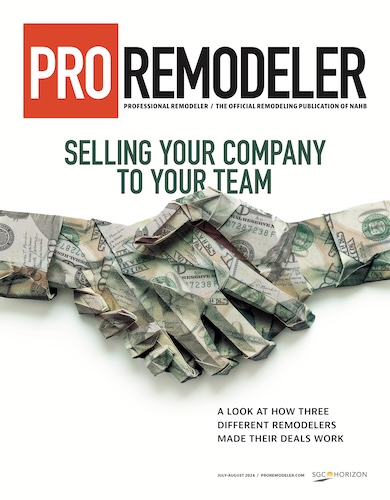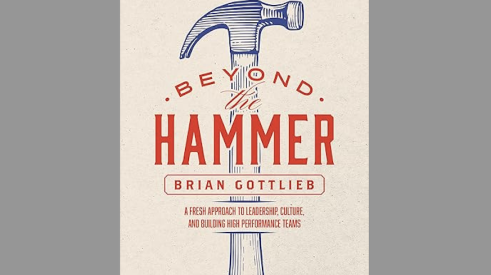 |
|
Paul Winans |
It is the beginning of the year. Once again, on your list of to-dos is "Business plan." You are stuck, as you have been in the past. How do you create a plan that makes a difference in the day-to-day operation of a company?
The best place to start is at the beginning. You started the business for a variety of reasons, one of which is likely to be the need to earn money. That is not a compelling vision for the company, however, particularly for all the people who work in and with the company.
What is your vision for your company? What are the drivers, the motivators and the reasons for it to exist? What is the company passionate about? What is it about your company that gets you out of bed every morning?
These are important questions. The person who holds the answers is you — the business owner.
The typical remodeling business owner wears many hats. It is not unusual for the owner to be wrapped up in what Stephen R. Covey in "The 7 Habits of Highly Effective People" calls the important and urgent: the stuff that needs to happen right now and the work that earns the company money.
This is a seductive trap that prevents the owner from being the vision setter. If the business exists but it is stuck, going no place fast, only by stepping back and looking at the big picture can the owner start focusing on those issues that are important and not urgent.
A mission statement says what the company is about now. It concentrates on the present; it defines the ideal customers and critical processes, and it describes the desired level of performance. A vision statement outlines what a company wants to be. It concentrates on the future; it is a source of inspiration; it provides clear decision-making criteria.
I like these definitions because they clearly distinguish between the two statements and provide direction to write some drafts. Keep in mind that these are to be, at most, several sentences. The easier they are to remember the more likely they are to be referenced on a day-to-day, decision-making basis.
Kraig Kramers in "CEO Tools: The Nuts-n-Bolts of Business for Every Manager's Success" stresses how important it is to create a vision that all your stakeholders can buy into. The vision must be exciting and relevant for everyone in the organization. When well-crafted, such a statement makes working together toward a challenging goal fun and encourages productive creativity.
In his books, author Jim Collins talks about the Hedgehog Concept. Imagine three overlapping circles. One is what you are deeply passionate about. The second is what you can be best in the world at. The third is what drives your economic engine.
The place where all three circles overlap is the Big Hairy Audacious Goal, or BHAG. A well-written BHAG is clear and compelling — and people get it right away. It serves as a unifying focal point of effort.
It is interesting to note that neither Kramers nor Collins talk at all about a mission statement. Their point is rather to provide a focus that moves the company forward, in writing, that all who work in the company can reference.
Michael E. Gerber in "The E Myth Contractor: Why Most Contractors' Businesses Don't Work and What to Do About It" suggests three questions to address when creating a business plan: Who are we? What do we do? How do we do it? The answers to the first two questions could be great starting points for creating a mission/vision statement.
So, how do you get started? As you go through your work week, jot down notes about the reasons your company exists and what the company would look like if it were successful. Ask your employees for input. This can be done informally at a regular company meeting or formally in writing.
Ask several of your best clients, trade contractors and suppliers for input. They all have opinions about your business; it is useful to hear what they have to say.
Review your notes. Start to winnow them down. Then create a draft. Don't wordsmith it too much.
Print the result in a typeface that is easy to read. Share it with your people, letting them know that you are interested in their feedback. Consider the feedback, incorporating what you think makes sense.
Then post it where everyone in the company can see it everyday.
This is a good start. With what you have created and how you put it together, you have a great beginning to your business plan.
Coming in May: The Next Steps — Values and Opportunities
| Author Information |
| Paul Winans works with Remodelers Advantage. He is a founder of Winans Construction, which he and his wife, Nina, sold in 2007. He can be reached at paul@remodelersadvantage.com. |
How do you create a plan that makes a difference in the day-to-day operation of a company?
Add new comment
Related Stories
3 Areas Successful Remodelers Focus On
Industry advisor Mark Richardson shares what separates the losing from the winning in today’s market
Peppermill Finish
The Neal’s Way Means Putting People First
For Neal’s Design Remodel, company culture is more than values on a wall. It’s everything.
Selling Your Company to Your Team
From company valuation to terms of the transfer, here’s a look at how three different remodelers made the deal work
Brian Gottlieb Receives Remodeling Mastery Award
Presented by industry icon, Mark Richardson, the award celebrated Gottlieb’s extraordinary impact on remodeling
What's Beyond the Hammer?
Working with Brian Gottlieb on the book Beyond the Hammer provided a masterclass on how to build an aligned team
Real AI Applications For Remodelers
Tech-forward remodeler Michael Anschel shares how he uses artificial intelligence in his business
How to Eliminate Boring, Languishing Meetings
Leff Design Build ensures maximum productivity and efficiency through these straightforward methods
5 Counterintuitive Strategies to Improve Your Business
Follow these strategies to inspire employees, instill trust, and beat the competition
Couple Act As Much More Than General Contractors
How LBR Partners uplifts and educates their Spanish-speaking trade partners












